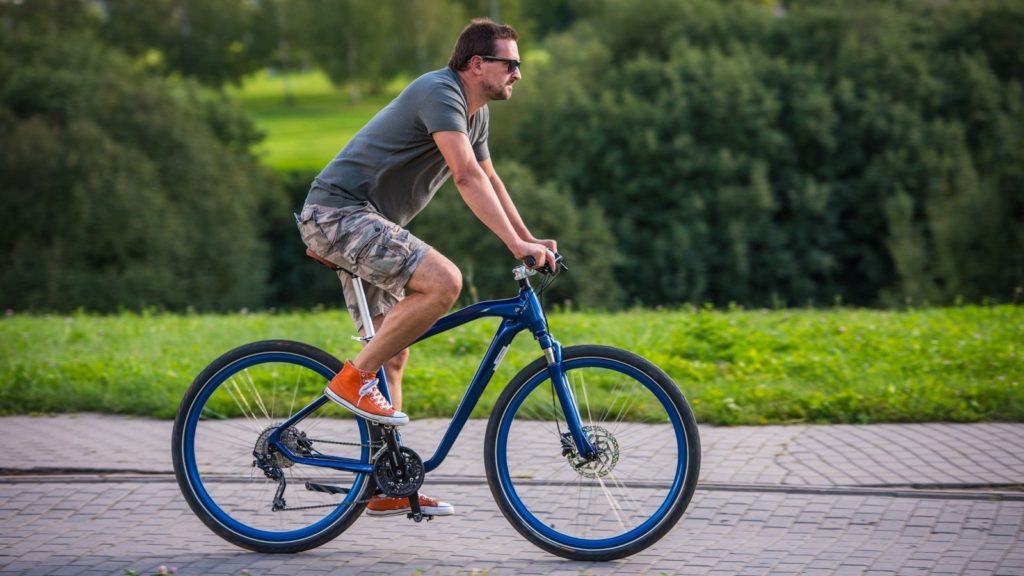The basic rules of cycling pedaling are approximately as follows. Pedals need to be turned, not crushed. Do not twist “slowly – but surely” a large gear – it is better to use a lower gear at high speeds with your working cadence (cadence). Try to ride in the saddle as much as possible (do not get up in vain) – this saves you energy. On prolonged lifts, do not strain your whole body – concentrate on the road, breathing and pedaling – but try to keep your body relaxed. Now consider all these rules in more detail.
Firstly, unlike the common opinion, the pedals of a bicycle should be turned exactly (in an imaginary circle along the axis of the carriage), and not put pressure on them.
This pedaling technique is called “spinning,” which means pedaling with high cadence and low resistance, instead of just pushing the pedals down in a higher gear (as beginners prefer). Used properly, the spinning technique will require less energy, more evenly distribute the load on the knees and muscles of the legs, and allow you to ride faster and further with much less fatigue.
When performing the spinning pedal technique (for this technique, the presence of clamps or automatic contact pedals is highly desirable), you must maintain a pedal speed of 60-90 rpm RPM. Concentrate on pedaling your legs in circles around the center of the carriage (circular pedaling). With circular pedaling, you apply force for a full pedal turn, and not just downward. For extra effort, you must pull the handlebars back and down for each pedal turn (while sitting on the saddle of the bike).
Cycle the bicycle pedals smoothly by rotating the connecting rods in a circle (rather than pushing the pedals in a large gear). Pull the pedals up from the lower position, push the pedal forward when it is in the upper position, push the tip down and “pull” the pedals from the lower position.
Try to practice pedaling with one foot, fasten one foot to the pedal (tuklips or contacts) and push forward, down, back and up on the “reverse” (only with one foot). Feel that on each pedal turn the force is distributed evenly along the entire length of the circular motion. Continue to develop the technique of circular pedaling until pedaling with one foot is uniform, convulsive, impulsive and there are no “blind spots”.
On slow, steep climbs, press your elbows to your torso. This helps keep the front wheel from wandering and drifting as you tire more slowly.
Secondly – don’t do it slowly (with a cadence lower than 60rpm) to turn a large gear – it is better to use a lower gear at high speeds with your working cadence (cadence). The experience of world competitions shows that for long knee work without injuries it is better to pedal often (60-90rpm). In addition, the economy of slow pedaling in high gear is an illusion; it is precisely such pedaling that causes the greatest fatigue. It is for this reason that pedaling is so carefully crafted in bicycle schools.
Thirdly, the “dancer” technique (standing pedaling) provides higher traction and speed (without headwinds) – but at the same time leads to faster fatigue compared to sitting in the saddle pedaling. This technique must be used if you cannot “climb” the mountain while sitting in the saddle, if you feel the strength to catch up with your opponent, or you just need to change your position for a short period of time. With this technique, pedal as low as possible. You should apply your weight mainly to the rear wheel. Do not use an excessively low gear, otherwise you will certainly stall on the first obstacle or you will waste your energy in an empty
Fourth – do not strain;) Be relaxed. To save energy, always stay relaxed. Do not strain your face and upper body on the rise. Keep everything free to save energy. Concentrate on breathing and maintain a rhythm of deep and steady breathing. This will prevent shortness of breath. Do not grab hold of the wheel with a dead grip, bend your elbows, relax your torso.


